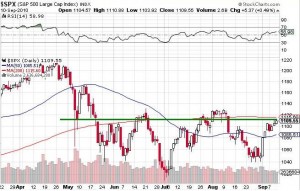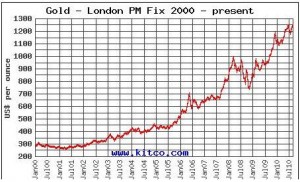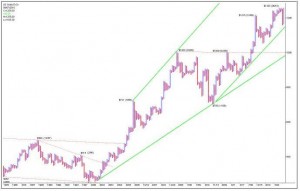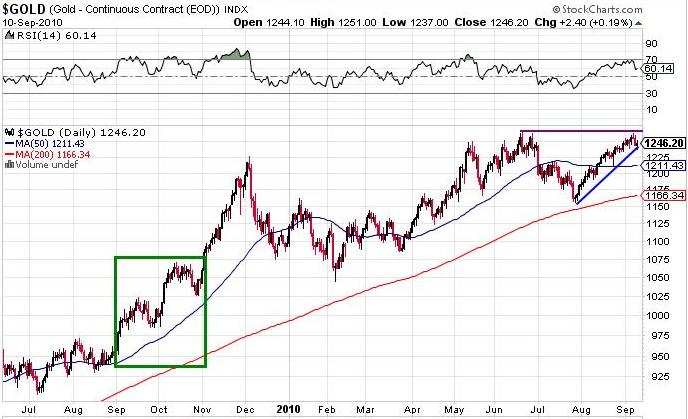This week, let’s review the charts. We are stuck in a trading range, and everyone who has predicted a market crash has, so far, missed the mark. Those predicting a big rally are also missing the boat. The truth is, nothing much has happened over the last few months. Here’s the S&P over the last few months (click the chart to enlarge):
As you can see, the S&P 500 closed at 1,109, which is about where it was on August 10, and July 26, and June 21, and June 15, and May 19, and May 7. That’s four months of going nowhere. That’s what you call a “trading range”. Not very exciting.
This lack of movement, not surprisingly, has been accomplished with low volume. As reported by Bob Pasani at CNBC, in the first five trading days of September, volume on the NYSE was 31% less than the same period last year. The VIX is at it’s lowest levels since the “flash crash” on May 6. But that’s not the interesting part. What’s interesting is who is doing the trading:
1 ) High frequency traders are 56 percent of all trades. This includes proprietary trading shops, market makers, and high-frequency trading hedge funds, according to Tabb Group. But as volume and volatility drops, this group gets less opportunity to profit from the statistical arbitrage trades most of them do.
2) Institutional traders (mutual funds, pensions, asset managers) are 17 percent of the volume. They, along with retail traders using their own account (11 percent) are seeing less activity because average investors have been WITHDRAWING money from equity mutual funds for two years.
3) hedge funds (15 percent of volume) have also been trading less because stock picking has not been very effective this year — it’s been mostly about getting the macroeconomic direction right.
The market isn’t you and me, the average retail investor. The average retail investor is long gone, having spent the last two years withdrawing money from equity mutual funds, and the market in general. That’s not surprising, since as we lose our jobs we need cash to survive, not to invest.
By the way, if you extend the chart of the S&P 500 farther back, we were around the 1,109 mark back on February 2, and on December 31, 2009, and November 18, 2009, and on April 12, 2002, and February 13, 1998.
Yes, that’s right, the market is at the same place it was last month, seven months ago, eight years ago, and twelve years ago. How’s that for a trading range?
If you had bought $100 worth of stock on February 13, 1998, you would still have $100 worth of stock today. But, if you adjust for inflation, you only have $74.19 in purchasing power (if you believe the government’s official inflation numbers, as calculated using the Federal Reserve Inflation Calculator). By investing in stocks, over a twelve year period, you actually lost money.
That’s not good, and that’s why the average person is leaving the stock market, some never to return.
Gold
Of course, over the last ten years, there have been some investments that have increased in value, like gold; here’s the Kitco gold chart:
From $300 to over $1,200; even adjusted for inflation, that’s pretty good. Assuming gold doesn’t crash between now and the end of the year, this will be the tenth consecutive year where the price of gold has increased. Obviously you can’t say the same for stocks.
If you prefer a 25 year time horizon, here’s the chart. To save your eyes, go to The Privateer to see the original version. Obviously 1985 to the year 2000 was a period of consolidation. Then, on February 2, 2002, gold broke above the $300 per ounce level for good, and it has been onward and upward since then:
- $300 on February 2, 2002;
- $400 on December 1, 2003;
- $500 on December 1, 2005;
- $615 on April 17, 2006;
- $700 on May 9, 2006;
- $805 on November 2, 2007;
- $900 on January 14, 2008;
- $1,000 on March 17, 2008;
- then gold dropped all the way to $705 on November 13, 2008, then back to
- $1,000 on February 20, 2009; then nothing for the year until gold recovered back to
- $1,005 on September 11, 2009, exactly one year ago today, then
- $1,100 on November 9, 2009;
- $1,200 on December 1, 2009;
- then a double top at $1,240 on June 28, 2010, which didn’t last long, because by
- September 7, 2010 gold hit an new all time high of $1,255.
That’s a lot of numbers. What does it prove? It proves that gold is volatile, falling from $1,000 on March 17, 2008 all the way to $705 241 days later. Of more interest is the speed at which gold can move:
- it took 137 days to go from $500 to over $600;
- only 22 days to go from $615 to $700;
- $805 to $900 took 73 days;
- $900 to $1,000 took 63 days;
- $1,005 to $1,100 took 59 days;
- and the push from $1,100 to $1,200 was accomplished in only 22 days.
Yes, I understand math, and I understand that a move from $1,100 to $1,200 is only a 9% move, as compared to a $500 to $600 move which is 20%, but the facts are clear: when gold goes on a run, it can move very quickly.
More interesting trivia for you:
New highs at $400, $500 and $1,200 were achieved in December (in 2003, 2005, and 2009). New highs of $800 and $1,100 were achieved in November (2007 and 2009). The next best “new high that’s a round number” month is February ($300 in 2002, and $1,000 in 2009). Only one return to a nice round number happened in September (that was last year, when we hit $1,000 in February, dropped a lot, and then recovered back to $1,005 one year ago today, on September 11, 2009). No new round number highs were achieved in October.
What does this mean? Probably nothing, other than November and December are good gold months; September and October, not so much. That leads me to conclude that there is no need to be an aggressive gold buyer over the next few weeks. However, the next six weeks will be a good time to put in aggressive stink bids on the gold stocks you want to own for the more favorable period, starting after Halloween.
Of course, last September and October were volatile but still positive months, so you don’t want to wait too long or else the train may leave the station. The green box is the action last September and October:
So what’s my plan?
As time permits, over the next week I’m going to review all of the precious metals stocks on my watch list. I’m going to set my stink bids for all of them, with a view to being close to fully invested by Halloween, or early November. I still believe there is a good chance of a further general stock market correction this month or next, so I’m not in a big hurry to grab my positions. However, I don’t want to miss the boat, either.
I will report the specifics next week.
Thanks for reading, and have a good week.




{ 0 comments… add one now }
You must log in to post a comment.